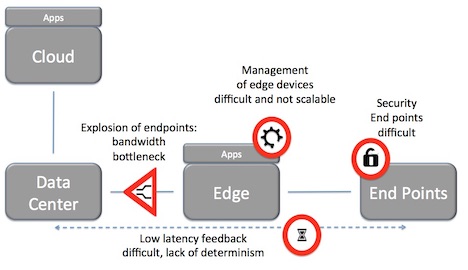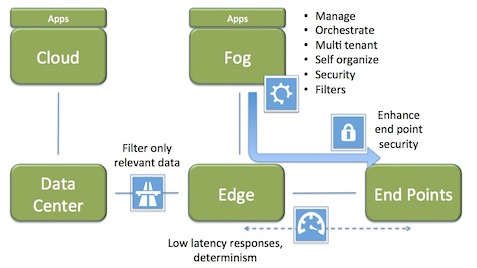The Internet of Things (IoT) has been among us for a while, but in recent years we have seen a change in scale, in part due to cheaper sensors that are emerging. Cities are deploying sensors to improve the quality of life for their citizens, while factories are connecting more and more machines and collecting more data about the production processes. Supply chains are being revolutionized by tracking in real-time not only position but also movement (shaking, dropping), humidity, etc… In almost every industry you can see the impact of IoT.
Due to this change in scale new challenges are starting to emerge that are demanding a rethink of the Cloud only paradigm, and the silo approach to IoT.
Challenges
IoT typically means deploying application intelligence and analytics at the edge (the area between Cloud/data centers and end points such as sensors, factory robots, etc…), or pushing data directly to the Cloud for processing. Both approaches have their advantages as well as potential drawbacks.

The network between the edge and the Cloud can be relatively expensive (especially if you send all data to the Cloud) or has limited capacity (capacity is of course correlated with price). Latency to the Cloud can also be relatively high, and often lacks determinism. For example changing the color of traffic lights via the Cloud might not be optimal.
More and more solutions are being deployed at the edge to address the challenges Cloud faces. But these solutions have their drawbacks too. Many different solutions (hardware and software) make it more challenging to manage these edge services in a consistent and coherent manner.
IoT deployment is typically not confined to the traditional enterprise IT domain (au contraire). This means that traditional security solutions do not always apply, resulting in potential high risk security breaches: it is not only about stealing data, but also about controlling machines For example manufacturing robots, location of vehicles, …
One of the trends that we are seeing is that providers of edge services want to focus on their service (application) as this is where their expertise is. Today however many providers also need to provide the hardware (not always a good source of revenue), a certain level of security (not always their primary level of expertise), and a way to manage their services and devices (which can pose a challenge if a customer deploys multiple silos of IoT services).
A Unified platform beyond Cloud only
To address the challenges described above, a rethink is needed. On one hand the Cloud only paradigm is not sufficient, yet such a new platform needs to support a Cloud like methodology for the edge.

The emphasis here is on “like”, as the edge differs from a Cloud/data center in several important aspects such as: limited resources, limited network capacity, security challenges, and resource distribution. However, such a platform will also have things in common with Clouds. Just like in a Cloud environment it needs to manage the (edge) service life cycle and orchestrate deployment.
With such a platform in place, edge service providers can focus on their core business as this new platform provides them with hooks to develop, deploy, scale, monitor, and manage their services in a secure and safe environment while seamlessly connecting to the Cloud.
Moving to Cloud and beyond
The vision of such a unified platform has been described by Bonomi et.al. and labeled Fog Computing. We are now seeing this vision unfold in several distinct stages.
Unified (IP based) connectivity is typically the first stage. For example, cities offering free Wi-Fi in the city center, or factories that are consolidating their different networks.
Once unified connectivity is in place, it becomes easier to deploy services at the edge by connecting hardware to this IP network. This can lead to service silos, which are sometimes difficult to avoid due to legacy applications and hardware.
The next stage is the deployment of a unified platform (Fog platform) between Cloud and the endpoints to enhance service deployment beyond the Cloud but also to spur innovation by making it easier to share data between these services. This stage is where there is a true added value, as service management is unified and hardware platforms can become more consolidated.
This paradigm shift to think beyond Cloud towards a unified platform, will lead to new products, services and business models, but can also increases the risk of fragmentation due to lack of standards, architectural vision and abstraction. In order for this paradigm shift to truly succeed it is therefore important to have a continuous conversation between the IT and OT industry.
To ensure companies capture the value of IoT, it is important to start the thought process on a Fog and IoT vision early on: service deployments, connectivity capacity beyond Cloud, data filtering and analytics at the edge, device consolidation, real-time requirements, etc…
Such an IoT vision will enable companies to better prepare and understand the risks and opportunities in an increasingly connected world.

CONNECT WITH US